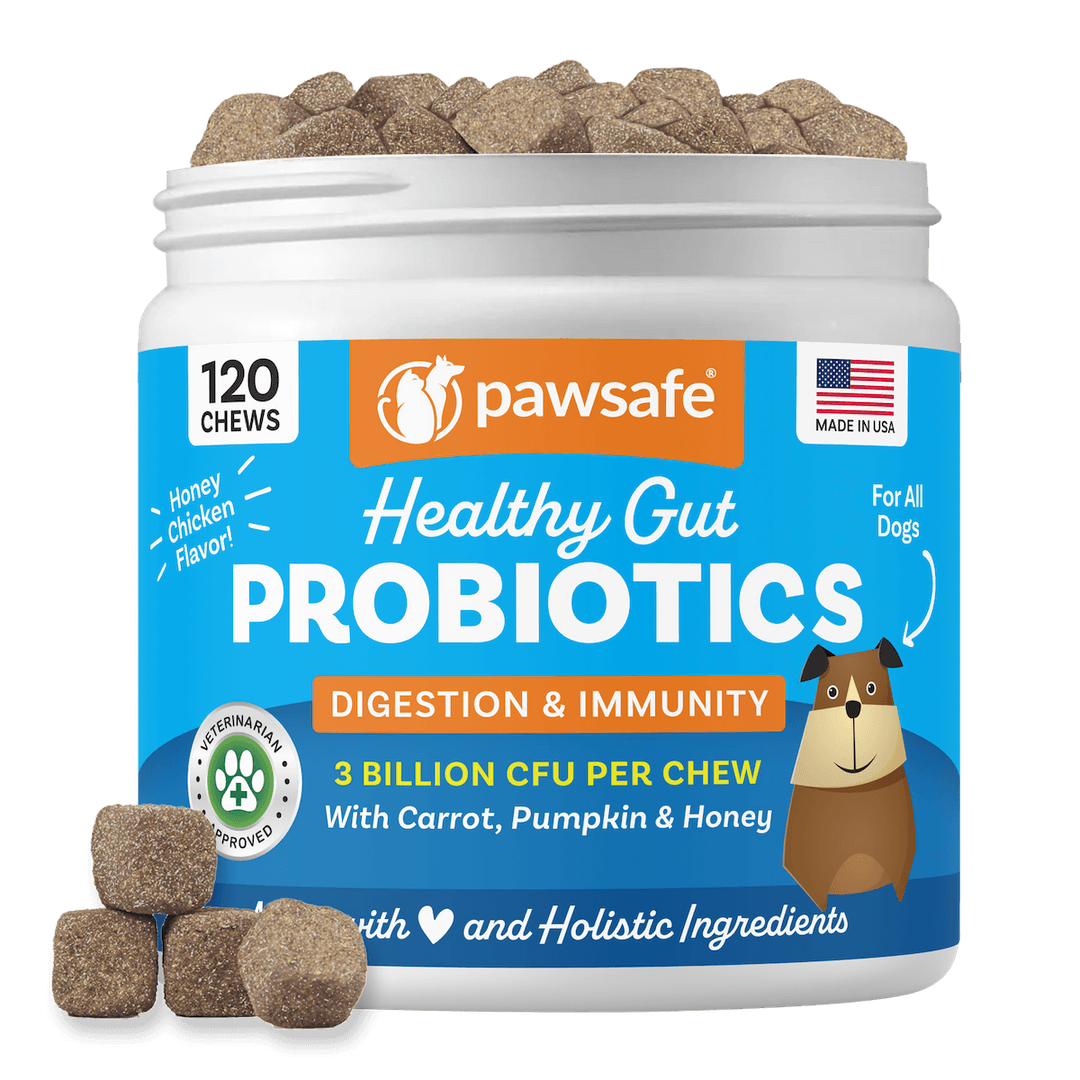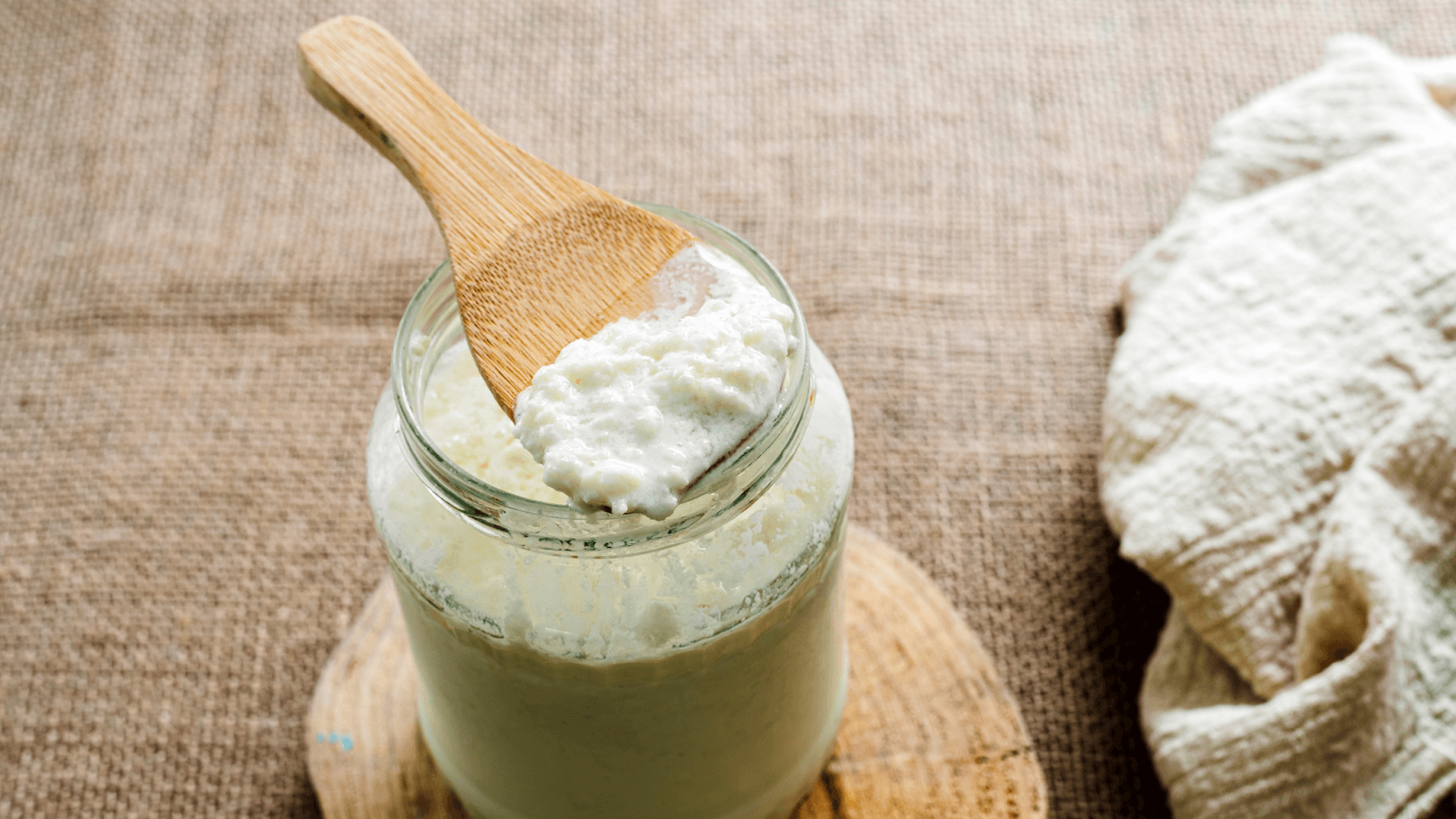
With my work in canine nutrition[1] over the years, I have to say I have become skeptical of a lot of natural and home remedies for dogs. I don’t like adding anything to my dogs’ diets that doesn’t have good research behind it. However, kefir is one of the few natural probiotics that actually add to my own dogs’ food because of the many proven benefits.
In this article, we delve into the various advantages of kefir, especially looking at kefir’s role in canine gut health[2], allergies and even wound healing. We will explore the different types of kefir available and offer guidance on how to incorporate this nutritious food into your dog’s diet safely. So, let’s uncover the benefits of kefir for dogs, backed by professional insights and the latest studies in the field of canine nutrition.
Table of Contents
- So, Is Kefir Good For Dogs?
- What is Kefir?
- Kefir For Canine Gut Health
- Manages Dog Allergies
- Supports Kidney Health in Dogs
- Kefir's Role in Wound Healing in Dogs
- Choosing the Right Kefir for Your Dog and How Much to Give
- Homemade Goat's Milk Kefir for Dogs
- How Much Kefir to Give Your Dog
- Is Water Kefir an Option?
- Can You Freeze Kefir for Dogs?
- Final Thoughts: Integrating Kefir into Your Dog's Diet
- References
So, Is Kefir Good For Dogs?
Yes, kefir is good for dogs. It’s a probiotic-rich food that aids in digestion, supports gut health, is anti-inflammatory, and can boost the immune system. It’s also helpful for improving skin and coat health, and may assist in preventing certain allergies and diarrhea. However, it’s important to know what kind of kefir to give your puppy and how much to give your dog safely.
Personally, I give my dog’s a few homemade spoonfuls mixed in their dog food everyday. I have definitely noticed far fewer tummy troubles, shinier fur, and just general better health overall.
So, let’s look at what this superfood is, what the benefits are according to scientific studies, which kind is right for your dog, how to make it, and how to incorporate it in your dog’s diet.
What is Kefir?
Kefir is a fermented beverage that originates from the Caucasus Mountains, with a history that spans centuries. Traditionally made from cow, goat, or sheep milk, it is produced by adding kefir grains to the milk. These grains are not grains in the normal sense but are a symbiotic culture of bacteria and yeasts (SCOBY) that ferment the milk, transforming it into kefir.
The fermentation process not only gives a unique, slightly tangy flavor to kefir but also generates a host of beneficial probiotics, vitamins, and minerals. These include vitamins B12 and D, calcium, magnesium, and various bioactive compounds. The final product is a slightly thickened, foamy drink that is similar to yogurt but with a thinner consistency. So let’s look at the health benefits of this product, how to make kefir at home, and how to give your dog kefir.

Kefir For Canine Gut Health
About 70% of a dog’s immune system is their gut. The gut lining is vital for keeping out pathogens and particles that your dog may be allergic to. Dr. Elizabeth Mondo[3] and her colleagues explain the need for a healthy gut biome to keep dogs healthy.
When all the bacteria in a dog’s tummy is balanced, it is called “eubiosis.” It’s like having the right mix of people, each doing their own important job, keeping the city running smoothly.
But sometimes, this balance gets messed up – that’s “dysbiosis.” This is when:
- There is Less Variety of bacteria;
- The healthy Bacteria die off; and
- The Bad Bacteria Move In.
When this happens, it can lead to all sorts of problems like stomach issues, allergies, skin problems, obesity, and even mood changes. In fact, Dr. Amanda Blake[4] even links bad gut health to atopic dermatitis and diabetes. Dogs with dysbiosis often experience digestive issues and soft stools.
This is where our favorite fermented drink comes in. It’s like sending in a team of super helpers into the city. Kefir is full healthy bacteria that help bring back the balance. It’s like they help the good guys and kick out the bad guys in the intestines.
Scientists recently discovered something great about it. They gave dogs this fermented product for two weeks and found it really helped their stomach health. Here’s what they found:
1. Good Bacteria Goes Up
Kefir adds more probiotics to your dog’s stomach, which is great for their health.
2. Bad Bacteria Goes Down
There was also less of the bad bacteria. This means it is making the dog’s gut a better place.
3. Overall Healthier Stomach
The study saw a healthy shift in the types of bacteria in the dogs’ stomachs. Even the bacteria that can cause trouble were less common.

Daily Support For Healthy Digestion
Multi-strain probiotic soft chews that help maintain gut balance and stool quality in an easy, tasty format.
Shop Now 👉Vet Approved Formula • 90-Day PawSafe® Promise
4. Kefir is Safe for Dogs
The best part? Kefir didn’t cause any problems for the dogs. It’s both safe and good for them.
Why Kefir Works
This is is a big deal because it actually works in a dog’s stomach. Here’s why that’s important:
Not All Probiotics Are the Same
Most probiotics for dogs aren’t tested or proven to work, and some lack live bacteria. This is one of the few products you can actually give your dog that really helps their gut.
Surviving the Stomach Trip
It also has strong bacteria that can survive in a dog’s tough stomach environment. What many people overlook is that a dog’s stomach simply is too acidic for most probiotics to survive.
Kefir vs. Yogurt For Dogs: Which is Better?
Contrary to popular belief, yogurt is not an effective probiotic for dogs for two reasons. Firstly, yogurt typically contains only about 50 million CFUs (colony forming units), which just isn’t enough bacteria to colonize a dog’s gut. Canine probiotics need 1-10 billion CFUs to be effective.
Plus, common yogurt bacteria like Streptococcus thermophilus and* L. Bulgaricus *do not survive in a dog’s bile.
On the other hand, Kefir is a good probiotic choice because it has a lot of CFUs and the good bacteria it has can actually survive a dog’s acidic gut.
Manages Dog Allergies

A strong gut helps dogs fight allergies like atopic dermatitis and food sensitivities. A strong gut lining, helped by good bacteria in foods like kefir, blocks harmful substances. The good bacteria make short-chain fatty acids that protect and strengthen the stomach lining.
Food allergies in dogs happen when their immune system wrongly identifies certain food components as threats.
This is because of a specific antibody known as Immunoglobulin E (IgE). When IgE connects with mast cells, it causes the release of substances that harm the dog’s tissues. This is an allergic reaction and studies show that low doses of kefir actually lowers the amount of these cells[5].
Supports Kidney Health in Dogs
Kefir may also help dogs’ kidney health[6].
Dogs often have serious health issues like chronic kidney disease and renal dysfunction. These problems can get worse because of things like high blood pressure. The peptides in kefir, which come from fermented milk, have shown promising results in fighting these problems.
The study showed that kefir peptides (strings of amino acids or proteins) can lower inflammation and oxidative stress, which can harm the kidneys. By combating these elements, these peptides help protect against renal dysfunction.
They also improve kidney health by reducing protein levels in urine and enhancing filtration capacity.
The anti-inflammatory and antioxidative properties of KPs could be instrumental in maintaining healthy kidney function in dogs.
Kefir’s Role in Wound Healing in Dogs
Kefir now shows promise in another area: wound healing. New research has found that it can help treat wounds.** Although we don’t recommend this as the best way to treat dog wounds, it’s interesting to note that it has great antibacterial properties.**
Choosing the Right Kefir for Your Dog and How Much to Give
Goat milk kefir stands out as an excellent choice for your dog’s health. Here’s why:
- Goat’s milk, compared to cow’s milk, is easier for dogs to digest. It’s less likely to cause allergies as it has the enzyme lactase, which breaks down the lactose in the milk. In general, dogs can’t digest lactose, so they should never get cow milk products. Goat milk is packed with good stuff like vitamins, minerals, and fatty acids. We also look at whether or not water or coconut kefir is a good option below.
- It contains a special probiotic strain that does well in a dog’s gut calledE. hirae.
- It is also rich in another probiotic called *Saccharomyces cerevisiae. *This strain in kefir fights bad bacteria, acts as an antioxidant, and helps with digestion.

Gut & Immune Support In One Chew
Targeted strains assist normal digestion while supporting natural immune defenses—simple once-a-day routine.
Shop Now 👉Vet Approved Formula • 90-Day PawSafe® Promise
A Warning About Pet Kefir Products
A recent study showed that kefir products for pets[7] might not always be what they claim. They often overstate the amount of good bacteria and may have different bacteria than listed. Here’s what you should know:
- Many pet kefir products exaggerate their bacteria content and don’t list the correct types.
- There’s a lack of regulation these products, leading to these inaccuracies.
Human-Grade Kefir: A Safer Option
Because of these issues, you might want to consider human-grade kefir:
- Human products are under stricter rules, so it’s more likely to have the good bacteria it claims.
- These products are made for human consumption, so they generally meet higher standards.
Another option for your puppy’s diet is to make it yourself. Here’s how.
Homemade Goat’s Milk Kefir for Dogs

If you want to ensure your dog gets the best quality stuff that’s the real deal, here’s a recipe you can use at home.
Ingredients
- 2 cups of fresh goat’s milk
- 1 tablespoon kefir grains (available at health food stores or online)
Equipment
- Glass jar (1-quart size works well)
- Non-metal stirring utensil (like a wooden spoon)
- Breathable cover for the jar (coffee filter, cheesecloth, or paper towel)
- Rubber band or string to secure the cover
- Strainer (plastic or stainless steel)
Instructions
- Clean the glass jar thoroughly and let it dry.
- Place the kefir grains into the jar.
- Pour the goat’s milk over the grains. Stir gently with the non-metal utensil.
- Place the breathable cover over the jar’s opening and secure it with a rubber band or string. This allows the mixture to ferment while keeping out contaminants.
- Place the jar in a warm area (around 68-75°F) away from direct sunlight. Let it ferment for about 24 hours. The exact time can vary depending on the temperature and how thick you want the kefir. Warmer temperatures typically speed up the fermentation process.
- After 24 hours, check the mixture’s consistency. It should have thickened to a consistency similar to buttermilk. If it’s not thick enough, let it ferment a few more hours and check again.
- Once fermented, strain it through a strainer into a separate container. This will separate the kefir grains from the liquid kefir.
- Transfer the kefir to a clean jar or bottle and refrigerate. It can be stored in the fridge for up to a week.
- The separated grains can be used immediately for a new batch or stored in a small amount of milk in the fridge for future use.
How Much Kefir to Give Your Dog
Start with a small amount of kefir, like a teaspoon, to see how your dog reacts. For tiny breeds, start with half a teaspoon. Keep an eye on their poop to make sure it does not upset their stomach. Gradually increase to a few tablespoons per day, depending on your dog’s size and tolerance. Always consult your vet before introducing new foods into your dog’s diet.

Make Digestive Care Effortless
Palatable soft chews your dog looks forward to, helping keep things regular and comfortable over time.
Shop Now 👉Vet Approved Formula • 90-Day PawSafe® Promise
Is Water Kefir an Option?
Typically, the preparation of water kefir involves using about 1/4 cup of sugar per quart of water. While Fermentation uses up most of this sugar, there’s often some left. So water kefir isn’t my first pick for dogs with specific dietary restrictions or sugar sensitivities.
Preferring Goat’s Milk Kefir
Given the sugar content in water kefir, you might prefer using goat’s milk to make kefir for your dog. Goat’s milk kefir offers similar probiotic benefits without the added sugar, making it a healthier choice for dogs. It’s easier to digest, less likely to cause allergies, and rich in nutrients beneficial for your dog’s overall health.
However, you can try small amounts of water kefir if goat’s milk kefir is too rich for your dog.
Coconut Kefir for Dogs: Points to Consider
Coconut kefir is another variation that some people recommend. You can make it by fermenting the water or milk of coconuts with the grains in place of milk. It’s dairy-free and often chosen by those looking for a plant-based alternative to traditional milk kefirs. However, I don’t like using coconut milk for dogs for several reason:
Concerns with Lauric Acid
- Coconut kefir raises concerns due to its high content of lauric acid, a type of saturated fat. Approximately 50% of the fat in coconut is lauric acid.
- Contrary to popular belief, ***lauric acid can be inflammatory to the stomach lining,***which could be detrimental to a dog’s digestive health.
- While medium-chain triglycerides (MCTs) are generally considered beneficial for dogs, lauric acid does not provide the same benefits. It’s a common misconception that lauric acid acts like other MCTs.
A detailed study that discusses the effects of lauric acid and its implications can be found in this article published in the MDPI[8]. This study provides in-depth insights into why lauric acid might not be as good for dogs as many believe.
Can You Freeze Kefir for Dogs?
Yes, you can freeze kefir for your dogs. Freezing it is a practical way to extend its shelf life and can be especially useful for creating frozen treats, like those you’d add to a dog lick mat for mental stimulation and healthy lick mat treats for puppies.
However, it’s important to note that while freezing kefir does not kill the probiotics, it may put them in a dormant state. Once it is thawed, these probiotics typically become active again. This means that the probiotic benefits are generally retained, even after freezing and thawing.
For best results:
- Freeze Freshly Made Kefir: Since you prefer giving it fresh to maximize probiotic benefits, freeze the kefir soon after you make it.
- Use in Moderation: When using frozen kefir as a treat, especially for young puppies, it’s important to do so in moderation. While kefir is healthy, any dietary changes or additions should be introduced gradually.
- Thawing: If you plan to use frozen kefir as a food supplement rather than a frozen treat, let it thaw in the refrigerator before serving. This gradual thawing helps preserve the integrity of the probiotics.
Note: Because Kefir is high in calcium, I never give too much to my growing dogs. This is because too much calcium can cause constipation, and disrupt proper bone development in young dogs.
Final Thoughts: Integrating Kefir into Your Dog’s Diet
In summary, it’s easy to see that this food, full of good bacteria, can be really great for your dog’s health. Kefir can help with their stomach, skin, and overall health. It’s definitely something good to think about adding to what your dog eats.
References
- Canine and Feline Nutrition. ScienceDirect. https://www.sciencedirect.com/book/9780323066198/canine-and-feline-nutrition
- Modulation of the intestinal microbiota of dogs by kefir as a functional dairy product - ScienceD.... ScienceDirect. https://www.sciencedirect.com/science/article/pii/S0022030219301961
- Role of gut microbiota in dog and cat’s health and diseases. Ajol. https://www.ajol.info/index.php/ovj/article/view/190200
- Dr. Amanda Blake. Wendyblount. http://wendyblount.com/articles/digestive/2Article-AnimalFrontiers-GutMicrobiota.pdf
- Preventive effect of kefir in BALB-c (Mus musculus) induced by ovalbumin towards relative amount .... Iop. https://iopscience.iop.org/article/10.1088/1742-6596/1430/1/012015/meta
- Anti-Inflammatory, Antioxidant, and Antifibrotic Effects of Kefir Peptides on Salt-Induced Renal .... Mdpi. https://www.mdpi.com/2076-3921/9/9/790
- Assessment of commercial companion animal kefir products for label accuracy of microbial composit.... Oup. https://academic.oup.com/jas/article/98/9/skaa301/5904066
- Obesity, Inflammation, Toll-Like Receptor 4 and Fatty Acids. Mdpi. https://www.mdpi.com/2072-6643/10/4/432/htm







